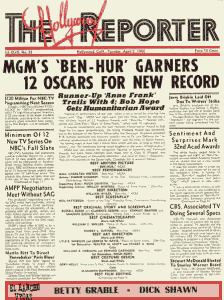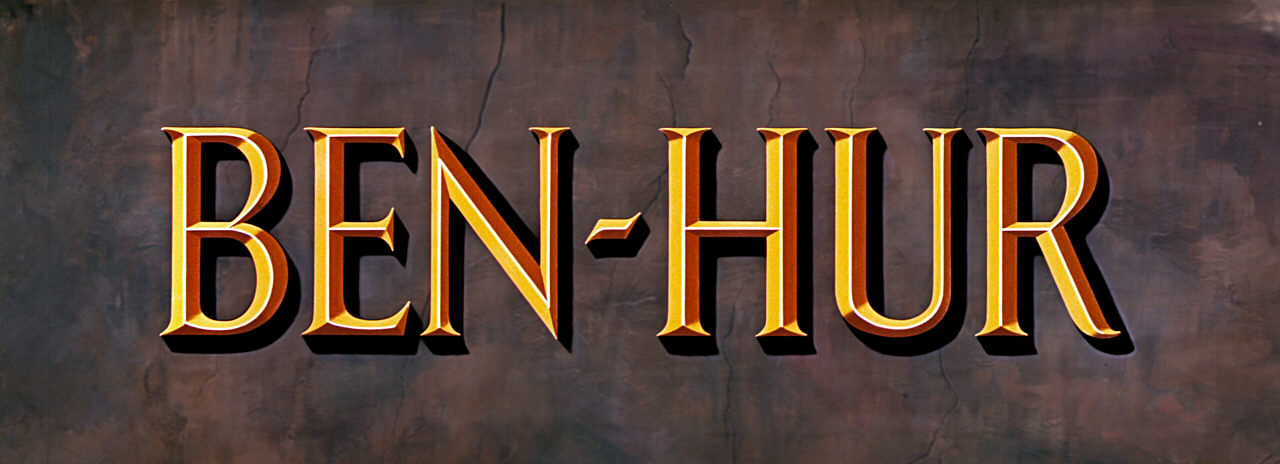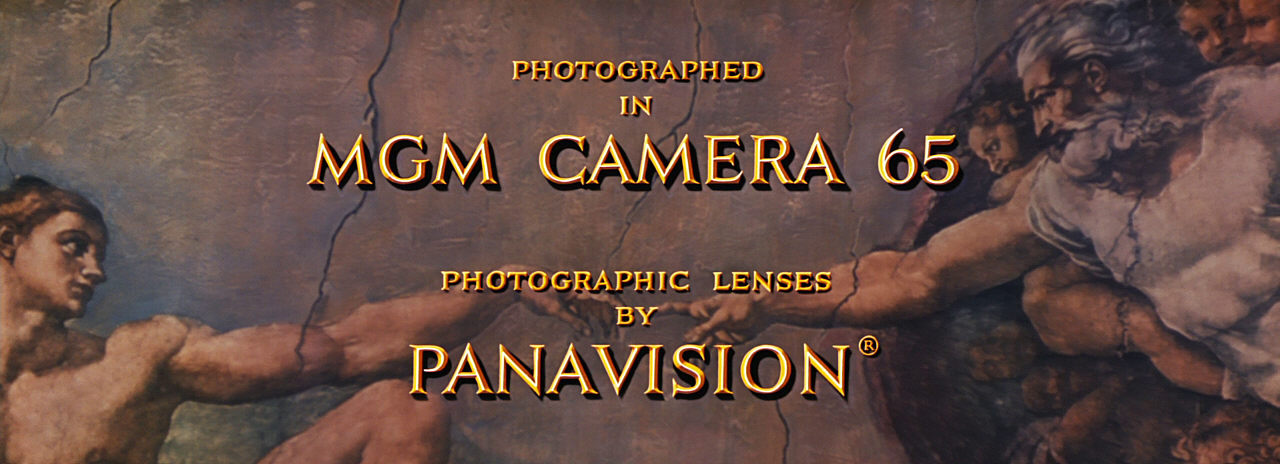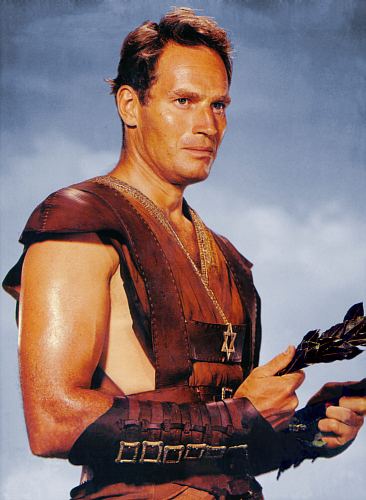The 70mm premiere of the Camera 65/Ultra Panavision
process came with the release of Ben-Hur on
November 18, 1959. The film won a record 11 Academy Awards, including best
color cinematography by Robert Surtees, best sound, and best visual effects
in addition to all those unimportant awards like best picture, director,
actor, supporting actor, music, editor, costume design, etc. Additionally,
a special technical Oscar was awarded to M-G-M and Panavision for the development
of the Camera 65 process.













©®AMPAS
Are you among the easily impressed? The curator
certainly is.
Titles That Raise Goosebumps
- Part 3


Sculptured gold letters over Michelangelo's
Creation of Adam, accompanied
by the power of Miklos Rozsa's finest film score, created an indelible and
electrifying impression on millions who saw this monumental production
on a large theatre screen. As was the case with most of Hollywood's top productions for decades, the title artwork and lettering for Ben-Hur was created by Pacific Title. You can visit the Pacific Title website by clicking their icon on our links page.
The extremely wide
2.76:1 aspect ratio of the film made it difficult and expensive for many
theatres to exhibit without curtailing screen height. But the expense that
theatres incurred to present the 70mm roadshow engagement paid off with
a run of nearly a full year. (It ran for three years in Rome, but that's
what it took for all the extras to get a look at themselves.) Following
the roadshow engagement, the film was then released in 35mm anamorphic
with four track magnetic sound in first run theatres around the nation.
After three to four months in the first run theatres, the film then moved
into the neighborhood theatres where booking lengths also exceeded the
single week norm by several months. The film played almost continuously
in most western countries for over 2 1/2 years.
The chariot race as seen in the full 2.76:1 70mm aspect ratio. Ben-Hur's spectacular photography
was matched with its extremely vivid 6 channel stereophonic sound. For practical reasons, the film was shown with an aspect ratio of about 2.5:1 in most roadshow houses.


The 70mm print illustrated here shows the slight 1.25:1 anamorphic
squeeze. The magnetic stripes carry the six channels of stereophonic sound.
The outer tracks each carry two channels and the inner tracks carry one
each. Like Todd-AO, there are five channels located behind the screen and
the sixth channel feeds auditorium speakers.
The 35mm CinemaScope compatible print has a 2:1 anamorphic squeeze
and carries a mix down of four channels of stereophonic sound plus a monaural
optical soundtrack. Unlike other M-G-M productions beginning in the mid
fifties, both Ben-Hur and Raintree County were printed in 35mm by Technicolor using the dye transfer process. The Ben-Hur prints were hard matted to a 2.5:1 screen ratio, thus preserving most of the width of the 65mm negative. The Raintree County prints were made in 100% CinemaScope compatible dimensions with an A/R of 2.35:1.
Having seen the 35mm Technicolor prints of Ben-Hur numerous times, your curator can attest to the incredible richness
that equalled any 70mm print of any film ever produced.
Everyone can name a film that had a lifelong impact on them. The
curator admits that this is the one that grabbed and has held his imagination
for five decades.
INDUSTRY NEWS
MGM To Use Ultra-Panavision
For Cinerama Productions
The versatile Panavision system of motion picture photography, which was described in an earlier issue of American Cinematographer as readily adaptable to Cinerama-type film production, will be utilized by MGM for its forthcoming Cinerama productions. The system, developed by Panavision's Robert Gottschalk, will be integrated with the three-camera, three-projector system of Cinerama in the four MGM-Cinerama co-productions, it is reported.
The Ultra-Panavision system includes also, a method for employing a single camera and a single projector to take and project motion pictures in a 360-degree periphery. MGM is said to be planning to integrate this method with the Cinerama system. |
This item was printed in the April 1961 issue of American Cinematographer magazine. As is typically the case with advance announcements, especially in the Never-Never Land of Hollywood, little of what is spelled out here actually came to be. Ultra Panavision was used to shoot some pieces for How The West Was Won but that was the last time it was used by MGM. Super Panavision was used for the last two MGM-Cinerama co-productions. What that 360 degree business is all about is anyone's guess, but it never appeared in anything relating to Cinerama or any other commercial motion picture.

You are on Page 4 of 





Read the complete text of the Ultra Panavision article written for
WideGauge Film and Video Monthly

